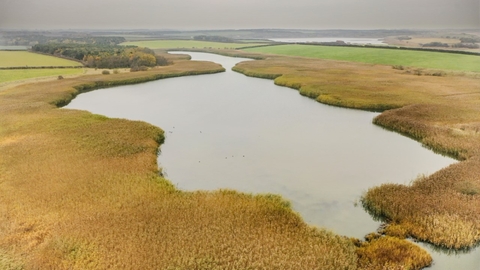
The South Lake on NWT’s East Chevington reserve at Druridge Bay. Image by: Andrew Bryson Photography.
Know before you go
Dogs
When to visit
Opening times
24/7/365Best time to visit
All year roundAbout the reserve
East Chevington nature reserve lies adjacent to the Druridge Bay Country Park, south of Amble and north of Druridge Pools and Cresswell Pond. The site was passed to Northumberland Wildlife Trust following opencast restoration in 2003. In addition to the two lakes, Northumberland Wildlife Trust also owns farmland to the west but this is only accessible along marked routes.
The reserve is considered as one of the best birdwatching sites in the county with large numbers of water birds using the lakes and the margins including terns, water rails and snipe. Spring and autumn see a wide range of migrant birds with large flocks of pink-footed geese overhead. Skylark, stonechat and grasshopper warbler breed on the site and can often be seen around the grassland areas and along the coastal path.
The expansive reedbeds through our extensive conservation work and Heritage Lottery Funded Biodiversity Boost Project have resulted in reed bunting, reed warbler and bearded tits to breed onsite and bittern to overwinter. Marsh harriers also rely on the reedbeds and first bred here in 2009, the first recording in Northumberland for 130 years. Barn owls and short-eared owls are often seen hunting along the grasslands and passage birds have included osprey and other birds of prey.
You can watch a YouTube video of our ongoing work in with the reedbeds here:- Reed Cutting at East Chevington (January 2025)
East Chevington’s grasslands support a wide range of plants such as dyer's greenweed, bloody, meadow and cut-leaved crane’s bill and bird’s foot trefoil. Five species of orchid can also be found onsite: common spotted, northern marsh, marsh helleborine, bee and lesser butterfly. Two new areas of wildflower meadow were planted last year thanks to the Heritage Lottery funded Catch My Drift project.
Mammals onsite include roe deer, harvest mice, water shrew, stoats and hares. Our smaller pools are home to great crested and smooth newts, with toads and frogs also common. The reserve has a great record of invertebrates. Wall and small heath are among the 21 species of butterflies to be recorded.
Please note there is one locked hide at the entrance to the site which is not accessible to the public as it is for education sessions. There are number of other hides available for public access. There are toilets and a café at the Druridge Bay Country Park (run by Northumberland County Council).
The road that runs through the site is the responsibility of the County Council and not Northumberland Wildlife Trust.
Species
- Barn owl
- Barnacle goose
- Bearded tit
- Blackcap
- Cuckoo
- Grasshopper warbler
- Greylag goose
- Lesser redpoll
- Lesser whitethroat
- Little grebe
- Marsh harrier
- Pink-footed goose
- Pintail
- Pochard
- Reed bunting
- Reed warbler
- Short-eared owl
- Skylark
- Starling
- Stonechat
- Swift
- Wheatear
- Whooper swan
- Wigeon
- Brown hare
- Common pipistrelle
- European otter
- Red squirrel
- Roe deer
- Stoat
- Water shrew
- Weasel
- Common frog
- Common toad
- Great crested newt
- Smooth newt
- Small heath
- Bee orchid
- Bloody crane's-bill
- Common bird's-foot-trefoil
- Common spotted-orchid
- Dyer's greenweed
- Meadow crane's-bill
